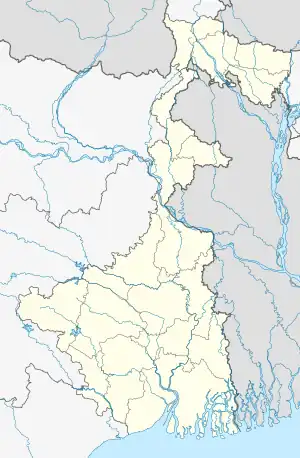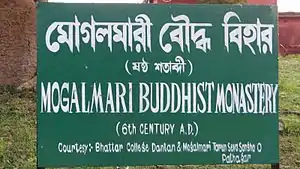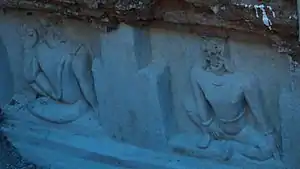 Stone Figure of 5th-7th Century CE excavated in Moghalmari | |
 Shown within West Bengal | |
| Location | West Bengal, India |
|---|---|
| Coordinates | 21°59′33″N 87°17′47″E / 21.99250°N 87.29639°E. |
| Type | Settlement |
| Site notes | |
| Ownership | Archaeological Survey of India |
Moghalmari or Mogolmari is a village and an archaeological excavation site in the Dantan II CD block in the Kharagpur subdivision of the Paschim Medinipur district of West Bengal. The excavation of the site which began in 2002–03, led by Professor Asok Datta of Calcutta University has revealed the presence of a Buddhist monastery dated between 6th to 12th Century.[1][2][3][4] A detailed excavation of the site started in November 2013 by the State Archaeological Directorate led to discovery of several artifacts and six tablets.[5][6][7]
Geography
CT: census town, R: rural/ urban centre, H: historical/ religious centre
Owing to space constraints in the small map, the actual locations in a larger map may vary slightly
Location
Moghalmari is located at 21°59′33″N 87°17′47″E / 21.99250°N 87.29639°E.
Excavation


The first detailed excavation of the Moghalmari site started in 2003 by a group of archaeologists led by Asok Datta from Department of Archaeology, University of Calcutta.[8] In the first phase of the excavation in 2003–04, two sites in the Mogholmari village was selected for the excavation. While the first site named MGM1, consisted of a structural mound with bricks strewn over the surface, locally known as Sakhisener dhibi or Sashisener dhibi.[8] The other site named MGM2 situated over present habitation, consist of five circular brick bases of stupas and pottery strewn over the surface.[8] The first site revealed a triratha projection in the western part of the site consisting of a wall running north–south which is considered to be a wall of a small monastic complex. The excavation also revealed square/rectangular structures (considered to be cells) apart from other antiquities.[8] The second site revealed three circular brick structures considered to be base of stupas. The artifact remains indicated that it belongs to 6th-7th Century. Further excavation revealed silt deposition of 55 cm and the artifacts found below that layer consisted of Black and Red Wares.[8]
In 2006-07 another extensive excavation was started on MGM1 and another site named MGM3. The excavations revealed a long wall covered with stucco decorations consisting of floral, animals and human figurines, and also evidenced two stages of construction of the structure. Another important discovery of the excavation was the discovery of a Buddha image on a slate stone.[8]
Another round of excavations in 2012 revealed various stucco figures in the walls with votive tablets having figure of Buddha as the central element, and flanked by Bodhisattas and Buddhist inscriptions.[2] The excavation also revealed a pradikshana path in the eastern and southern part of the site. The excavation has also revealed a central temple structure with cells surrounding a square courtyard. According to Rajat Sanyal, one of the member of the excavating team, the structure was constructed during the Vajrayana phase of Buddhism, where deity worship started in Buddhism, which can be inferred from the presence of figures of deities in the walls including Jambala and saraswati.[5] The figurines and the artifacts evidences towards influence of Gupta tradition of middle Ganga region.[1]
References
- 1 2 Shankar Chattopadhay, Suhrid (22 February 2013). "Unearthing a culture". Frontline. Retrieved 1 November 2013.
- 1 2 "Moghalmari excavations unveil West Bengal's Buddhist past". The Hindu. 5 April 2012. Retrieved 1 November 2013.
- ↑ Mukherjee Pandey, Jhimli (5 April 2012). "Dantan site may be the missing link of Hiuen Tsang's memoirs". The Times of India. Archived from the original on 22 October 2013. Retrieved 1 November 2013.
- ↑ "Nalanda buzz around Bengal Buddha statues". The Telegraph. 26 March 2012. Archived from the original on 30 March 2012. Retrieved 1 November 2013.
- 1 2 "Moghalmari excavation to start again". The Telegraph. 1 November 2013. Retrieved 1 November 2013.
- ↑ Sarkar, Sebanti (13 January 2014). "Buried in a village heap, history of Buddhist Bengal". The Telegraph. Archived from the original on 13 January 2014. Retrieved 13 January 2014.
- ↑ "Six terracotta tablets found at Moghalmari". Times of India. 13 January 2014. Retrieved 13 January 2014.
- 1 2 3 4 5 6 Kumar Datta, Asok (2008). Excavations at Moghalmari: first interim report 2003-04 to 2007-08. Kolkata: Asiatic Society.
See also
- Karnasubarna
- Mogalmari Bauddha Mahavihara